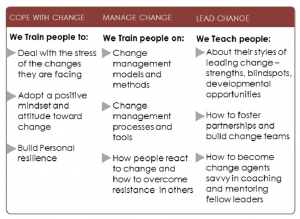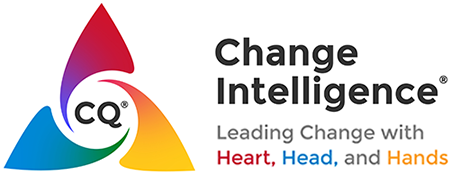What changes are your organization experiencing now? Merger, acquisition, reorganization? New technology implementation or significant upgrade? Major new product or service-offering launch?
Sobering statistics show that 70% of major organizational changes fail. We all know the carnage that results from these missteps – lost investment, customer dissatisfaction, employee cynicism.
What’s worse is that this failure rate has not changed in decades – research findings from the mid-1980s and mid-2010s demonstrate the same results.
While we have a LOT of experience with change, we have far less experience with change done right.
As a leader (and we’re all leaders, regardless of job title, hierarchical level, or functional group), what can you do? As I recommended in my keynote at HCI’s Human Capital / Talent Agility Summit last month, start by analyzing how your organization prepares people to take charge of change. When considering the types of learning and development opportunities you provide your workforce, how many of these bullet points can you say “yes” to:
 If you’re like most organizations, you answered “yes” to one or two Coping With or Managing Change learning opportunities, but “no” to all the critical competencies under Leading Change.
If you’re like most organizations, you answered “yes” to one or two Coping With or Managing Change learning opportunities, but “no” to all the critical competencies under Leading Change.
In most organizations, the focus is on the targets of change – those impacted – versus those leading the change; and also on managing change – the methods and tools – not on leading change.
The result is that employees are taught to reactively survive change, not how to genuinely take charge and thrive in these challenging times. People walk away from training sessions with thick binders and spreadsheets with boxes to check, not how to partner with people toward positive new directions.
Not that focusing on building personal resistance or learning the process of managing change is wrong – not at all – those are all important skills to equip our workforces. However, the learning and development opportunities we are providing our people at all levels are often incomplete, and inadequate to arm them with the capacity to competently and confidently lead change.
It’s not either/or – it’s both/and. What’s so often missing – and what I believe accounts for a significant proportion of the huge failure rate of major organizational change – is building change leadership capacity.
To help your organization achieve that mission-critical goal, create a more balanced portfolio of learning and development experiences that:
- Focus on people – not “just” process
- Focus on leaders – not “just” targets
- Focus on change leadership – not “just” change management
Like communications, coaching, and conflict resolution, change leadership is a vital competency of this VUCA (volatile, uncertain, complex, and ambiguous) world. Empower your leaders, teams, and organizations take charge of change!
